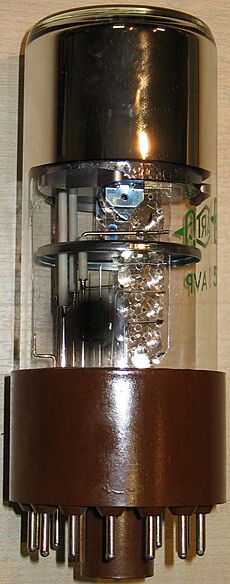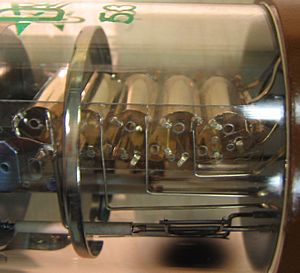Photomultiplier tubes facts for kids
A photomultiplier tube, often called a PMT, is a special device that can "see" and measure very tiny amounts of light. Imagine light as tiny packets of energy called photons. A PMT can turn these photons into a measurable electric signal, even if there's only one photon! This makes PMTs super useful for detecting very dim light, much dimmer than your eyes can see.
Contents
What is a Photomultiplier Tube?
A photomultiplier tube (PMT) is a device that changes light into an electric current. It's like a super-sensitive eye that can detect even the smallest amounts of light, such as a single photon. This makes PMTs very useful in many scientific and medical fields.
How a PMT "Sees" Light
When a photon (a tiny light particle) hits the front window of a PMT, it first strikes a special surface called a photocathode. This photocathode is designed to release electrons when light hits it. So, one photon can make one or more electrons pop out!
Multiplying the Signal
These released electrons are then pulled towards a series of other metal plates inside the tube. These plates are called dynodes. Each dynode has a slightly higher electric charge than the one before it. When an electron hits a dynode, it knocks out even more electrons from that plate. This process repeats many times, usually about nine times in a row.
Each time the electrons hit a dynode, their number grows. For example, one original photon can create millions of electrons (from 1,000,000 to 10,000,000 electrons!). This huge increase in electrons makes the tiny light signal much stronger and easier to measure.
Collecting the Signal
Finally, all these multiplied electrons are collected at a part of the PMT called the anode. At the anode, the large group of electrons creates an electric current and voltage. This current and voltage can then be measured by other electronic devices. This is how the PMT turns a tiny flash of light into a strong electrical signal.
Why PMTs are Useful
Photomultiplier tubes are incredibly sensitive and react very quickly to light. This means they can detect light that is too dim for human eyes or even regular cameras to see. They are also very fast, able to detect light changes in tiny fractions of a second.
To make PMTs even more sensitive and reduce unwanted "noise" (false signals), they can sometimes be cooled down. However, it's very important not to expose PMTs to bright light, like sunlight, because intense light can permanently damage their delicate parts.
PMTs are used in many different areas. For example, they are used in:
- Medical imaging: To see inside the body, like in PET scans.
- Scientific research: To study very faint light from stars or in experiments with tiny particles.
- Analysis techniques: To detect small amounts of chemicals or substances.
Images for kids
See also
 In Spanish: Fotomultiplicador para niños
In Spanish: Fotomultiplicador para niños




